2022届高中英语二轮专题语法复习之同位语从句课件(31张PPT)
文档属性
| 名称 | 2022届高中英语二轮专题语法复习之同位语从句课件(31张PPT) |  | |
| 格式 | zip | ||
| 文件大小 | 189.5KB | ||
| 资源类型 | 教案 | ||
| 版本资源 | 人教版(2019) | ||
| 科目 | 英语 | ||
| 更新时间 | 2022-04-26 19:16:40 | ||
图片预览


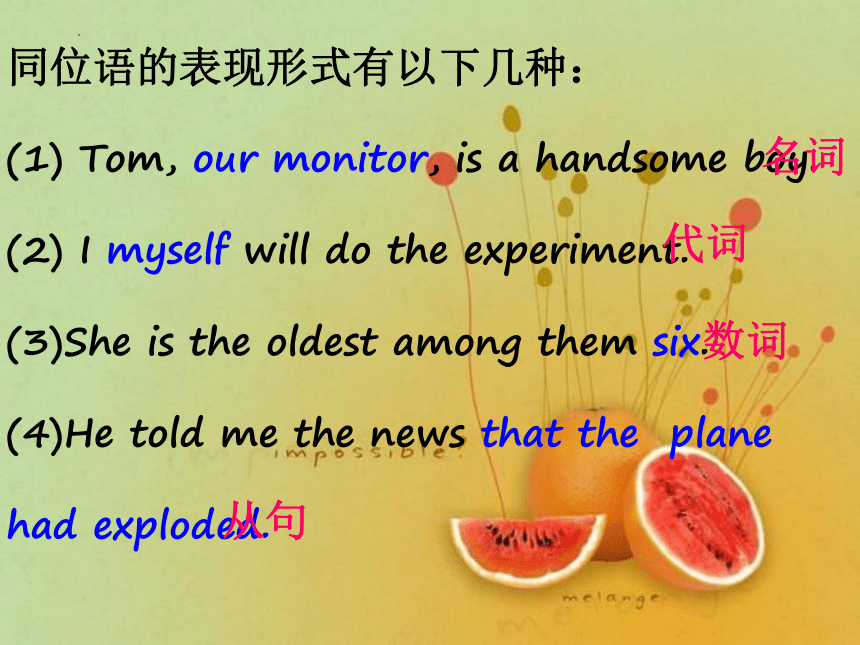
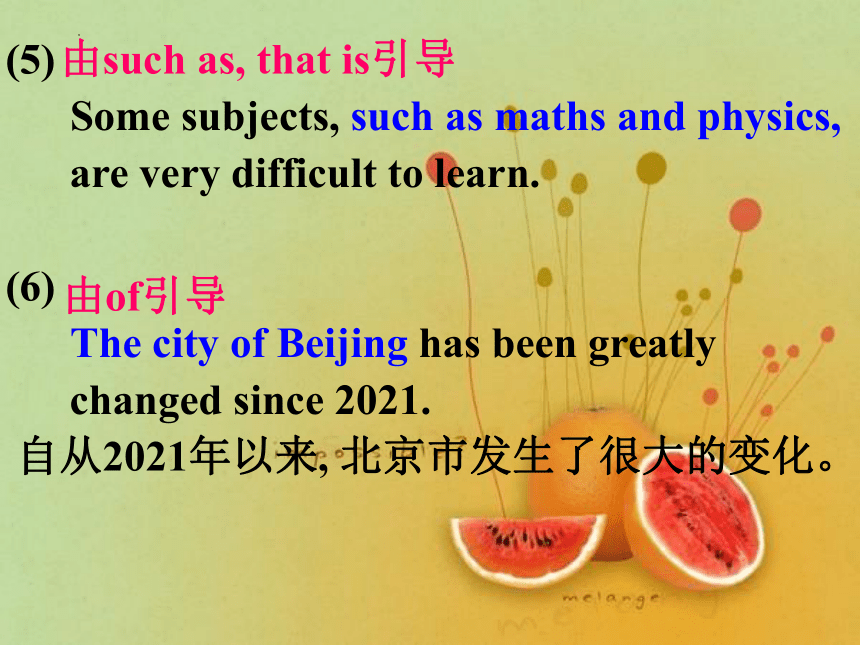
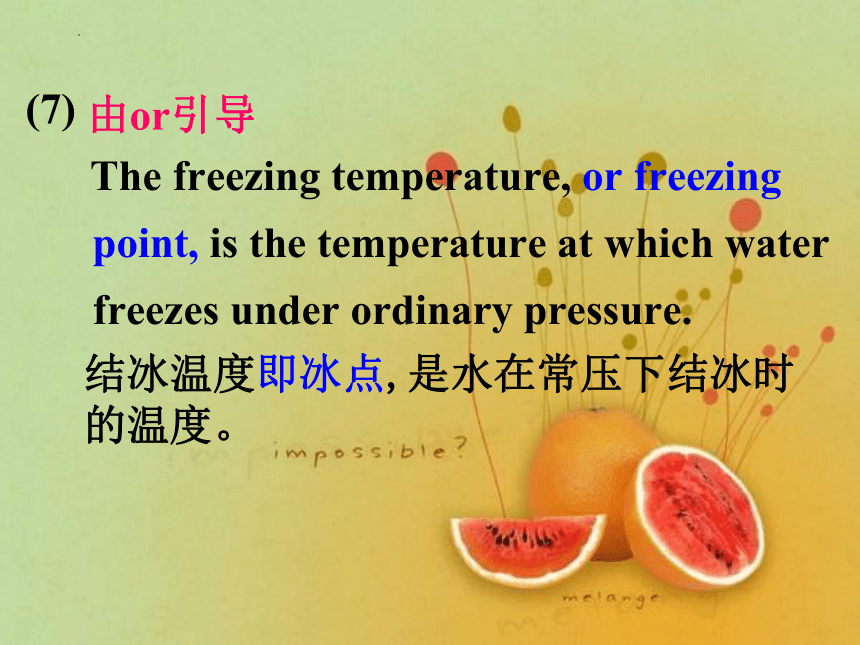
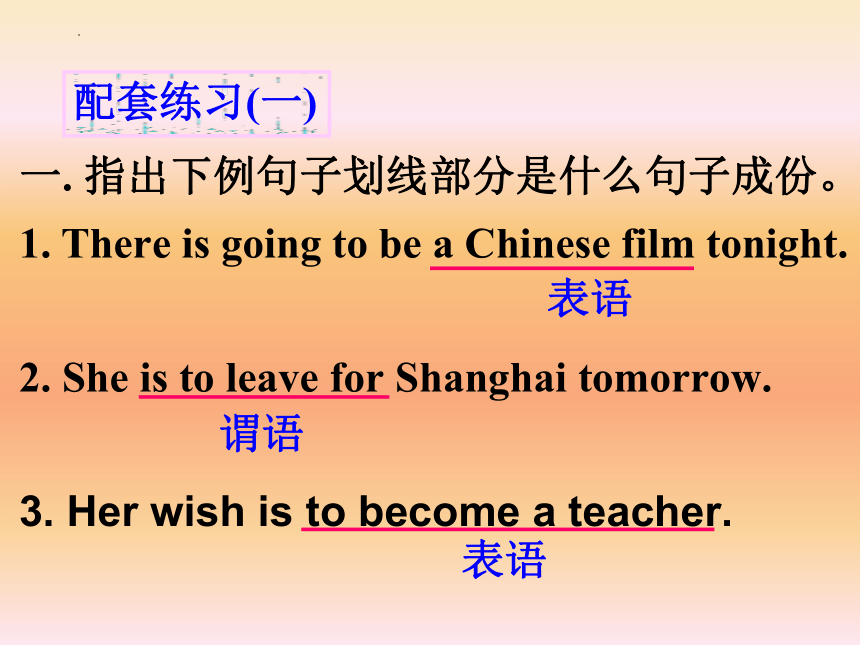
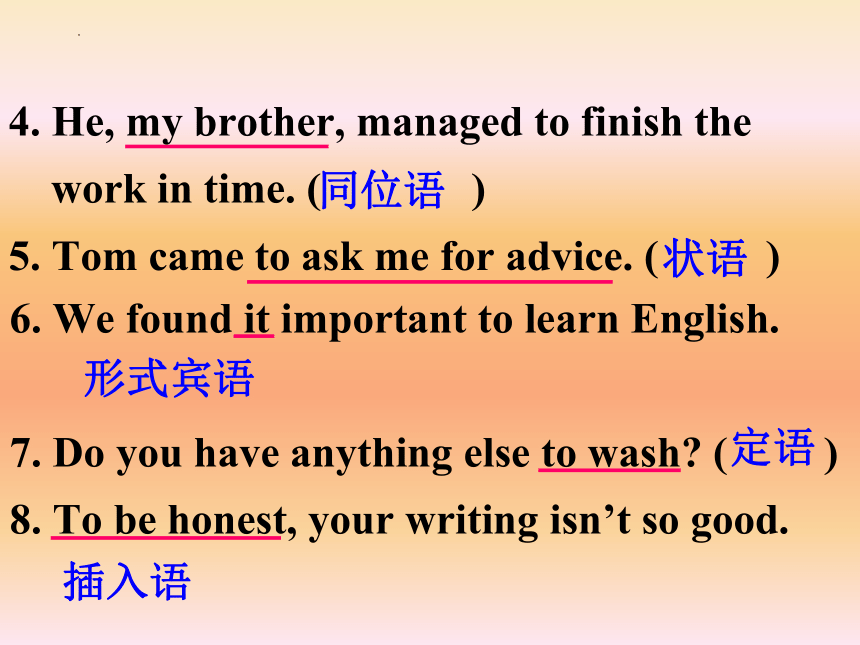
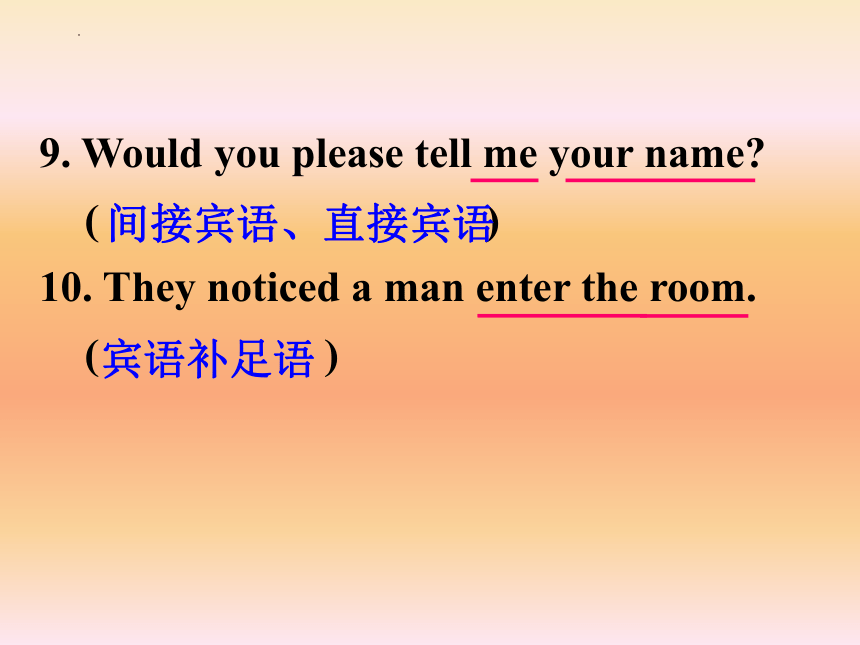
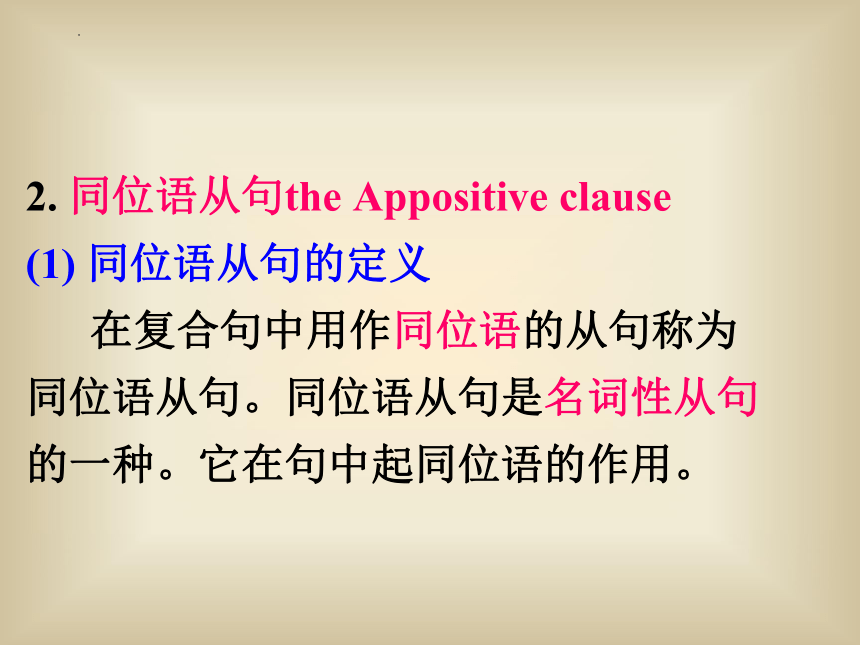
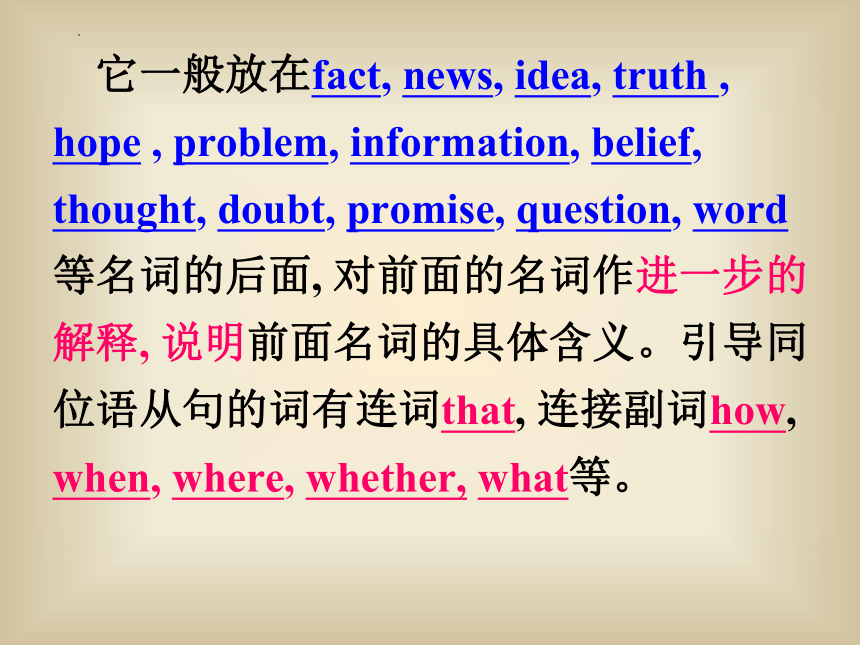
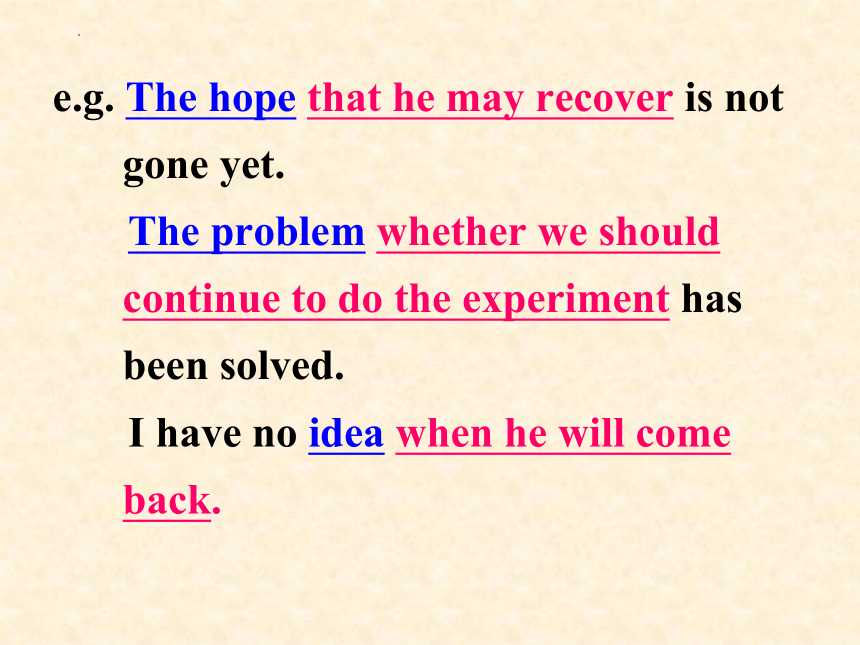

文档简介
(共31张PPT)
同位语从句
1. 同位语the Appositive
同位语是句子成分的一种, 它位于名词、代词后面, 说明它们的性质和情况;
它可以由名词、代词、名词性短语或从句充当。
同位语的表现形式有以下几种:
(1) Tom, our monitor, is a handsome boy.
(2) I myself will do the experiment.
(3)She is the oldest among them six.
(4)He told me the news that the plane had exploded.
名词
代词
数词
从句
(5)
Some subjects, such as maths and physics, are very difficult to learn.
(6)
The city of Beijing has been greatly changed since 2021.
自从2021年以来, 北京市发生了很大的变化。
由such as, that is引导
由of引导
(7)
The freezing temperature, or freezing point, is the temperature at which water freezes under ordinary pressure.
由or引导
结冰温度即冰点,是水在常压下结冰时的温度。
一. 指出下例句子划线部分是什么句子成份。
There is going to be a Chinese film tonight.
2. She is to leave for Shanghai tomorrow.
3. Her wish is to become a teacher.
配套练习(一)
表语
谓语
表语
4. He, my brother, managed to finish the work in time. ( )
5. Tom came to ask me for advice. ( )
同位语
状语
6. We found it important to learn English.
7. Do you have anything else to wash ( )
8. To be honest, your writing isn’t so good.
形式宾语
定语
插入语
9. Would you please tell me your name ( )
10. They noticed a man enter the room. ( )
间接宾语、直接宾语
宾语补足语
2. 同位语从句the Appositive clause
(1) 同位语从句的定义
在复合句中用作同位语的从句称为同位语从句。同位语从句是名词性从句的一种。它在句中起同位语的作用。
它一般放在fact, news, idea, truth , hope , problem, information, belief, thought, doubt, promise, question, word等名词的后面, 对前面的名词作进一步的解释, 说明前面名词的具体含义。引导同位语从句的词有连词that, 连接副词how, when, where, whether, what等。
e.g. The hope that he may recover is not gone yet.
The problem whether we should continue to do the experiment has been solved.
I have no idea when he will come back.
同位语从句有时被别的词把它和名词隔开:
注意:
The story goes that William Tell killed
the king with an arrow.
Word came that their team had won.
⑵ 同位语从句的表现形式:
① 由that引导
The news that he has been elected
president of the United States is true.
The truth that heavy objects and light
objects fall at the same speed is known
to all.
The problem that she later developed
a serious lung disease bothered
scientists.
② 由whether引导
The question whether we need more time to do the work has not been discussed.
③ 由when引导
I have no idea when they will go.
⑶ 有时用 namely (即), that is to say (也就是说), in other words (换句话说), that is (那就是), for example 等引出同位语, 说明其前面的名词或代词。
He told us the good news, namely, the museum is open to all.
There is only one way of improving your English , that is , to practice more.
⑷ 同位语从句与定语从句的区别:
① 同位语从句说明先行词的内容;
引导词不能省略。
定语从句修饰、限定先行词;
引导词在从句中充当宾语时可省略。
We express the hope that we will come to visit China again.
We express the hope that we will never forget.
同位语从句
定语从句
③ 同位语从句主要由连接词that引导,有时也可用when, where, who, whether等引导;
定语从句由关系代词或关系副词引导。
Then he raised the question where they were to get the machine needed.
Do you know the place where he was born
同位语从句
定语从句
练习
1. Two fifths of all girls in America are on a diet./The fact worries their parents and teachers a lot.
The fact that two fifths of all girls in
America are on a diet worries their
parents and teachers a lot.
把下面两个句子连成一个含同位语从句的复合句。
2. The Queen of England was on a four-day visit in China./We heard the news last night.
We heard the news last night that the Queen of England was on a four-day visit in china.
3. Teenagers shouldn’t spend too much time online. /Many Chinese parents hold the view.
Many Chinese parents hold the view that teenagers shouldn’t spend too much time online.
4. Time travel is possible./We have no scientific proof for the idea.
We have no scientific proof for the idea that time travel is possible.
5. Students should be given more free time./The suggestion is welcomed by many people.
The suggestion that students should be given more free time is welcomed by many people.
1.填入适当的连接词,并判断是定语从句还是同位语从句:
1) The fact____ he used to be a thief
is known to all.
2) We were surprised by the fact
_________ she told us.
3) The next thing ____ must be done
is to make a plan.
that
同
that/which
定
that
定
4) Word came ____ our army had won the battle.
5) The president has given an order that everyone in the country should prepare for a war____ might last for several years.
6) We've just heard a warning on the radio ____ a hurricane is likely to come.
that
同
that
定
that
同
1. One of them held the view __ the book said was right. A. what that B. that what C. that D. whether
单项选择
小试身手
2. The reason ___ he has to go is ___ his mother is ill in bed. A, why ; why B. why; because C. why ; that D. that ; because
3. They received orders ___ the work be done right away. A. which B. that C. / D. when
4. I think ___ certain that she will do well in her exam.
A. that B. this is
C. it D. what’s
5. The film brought the hours back to me ____ I was taken good care of in that far-away village. A. until B. that C. when D .where
6. He’s got himself into a dangerous situation __ he was likely to lose control over the plane. A. where B. which C. what D. why
7. That’s the only thing ___ he can do now. A. which B. all C. that D. what
8. Information has been put forward ___ more middle school graduates will be admitted into universities. A. while B. that C. when D. as
9. Along with the letter was his promise ___ he would visit me this coming Christmas. A. which B. that C. what D. whether
①同位语从句一般放在
等名词的后面。
②对前面的名词作进一步的解释, 说明前面名词的具体含义。
③引导同位语从句的词有连词that, 连接副词how, when, where, whether, what等。
fact, news, idea, truth , hope , problem, information, belief, thought, doubt, promise, question ,word
Summary
同位语从句
1. 同位语the Appositive
同位语是句子成分的一种, 它位于名词、代词后面, 说明它们的性质和情况;
它可以由名词、代词、名词性短语或从句充当。
同位语的表现形式有以下几种:
(1) Tom, our monitor, is a handsome boy.
(2) I myself will do the experiment.
(3)She is the oldest among them six.
(4)He told me the news that the plane had exploded.
名词
代词
数词
从句
(5)
Some subjects, such as maths and physics, are very difficult to learn.
(6)
The city of Beijing has been greatly changed since 2021.
自从2021年以来, 北京市发生了很大的变化。
由such as, that is引导
由of引导
(7)
The freezing temperature, or freezing point, is the temperature at which water freezes under ordinary pressure.
由or引导
结冰温度即冰点,是水在常压下结冰时的温度。
一. 指出下例句子划线部分是什么句子成份。
There is going to be a Chinese film tonight.
2. She is to leave for Shanghai tomorrow.
3. Her wish is to become a teacher.
配套练习(一)
表语
谓语
表语
4. He, my brother, managed to finish the work in time. ( )
5. Tom came to ask me for advice. ( )
同位语
状语
6. We found it important to learn English.
7. Do you have anything else to wash ( )
8. To be honest, your writing isn’t so good.
形式宾语
定语
插入语
9. Would you please tell me your name ( )
10. They noticed a man enter the room. ( )
间接宾语、直接宾语
宾语补足语
2. 同位语从句the Appositive clause
(1) 同位语从句的定义
在复合句中用作同位语的从句称为同位语从句。同位语从句是名词性从句的一种。它在句中起同位语的作用。
它一般放在fact, news, idea, truth , hope , problem, information, belief, thought, doubt, promise, question, word等名词的后面, 对前面的名词作进一步的解释, 说明前面名词的具体含义。引导同位语从句的词有连词that, 连接副词how, when, where, whether, what等。
e.g. The hope that he may recover is not gone yet.
The problem whether we should continue to do the experiment has been solved.
I have no idea when he will come back.
同位语从句有时被别的词把它和名词隔开:
注意:
The story goes that William Tell killed
the king with an arrow.
Word came that their team had won.
⑵ 同位语从句的表现形式:
① 由that引导
The news that he has been elected
president of the United States is true.
The truth that heavy objects and light
objects fall at the same speed is known
to all.
The problem that she later developed
a serious lung disease bothered
scientists.
② 由whether引导
The question whether we need more time to do the work has not been discussed.
③ 由when引导
I have no idea when they will go.
⑶ 有时用 namely (即), that is to say (也就是说), in other words (换句话说), that is (那就是), for example 等引出同位语, 说明其前面的名词或代词。
He told us the good news, namely, the museum is open to all.
There is only one way of improving your English , that is , to practice more.
⑷ 同位语从句与定语从句的区别:
① 同位语从句说明先行词的内容;
引导词不能省略。
定语从句修饰、限定先行词;
引导词在从句中充当宾语时可省略。
We express the hope that we will come to visit China again.
We express the hope that we will never forget.
同位语从句
定语从句
③ 同位语从句主要由连接词that引导,有时也可用when, where, who, whether等引导;
定语从句由关系代词或关系副词引导。
Then he raised the question where they were to get the machine needed.
Do you know the place where he was born
同位语从句
定语从句
练习
1. Two fifths of all girls in America are on a diet./The fact worries their parents and teachers a lot.
The fact that two fifths of all girls in
America are on a diet worries their
parents and teachers a lot.
把下面两个句子连成一个含同位语从句的复合句。
2. The Queen of England was on a four-day visit in China./We heard the news last night.
We heard the news last night that the Queen of England was on a four-day visit in china.
3. Teenagers shouldn’t spend too much time online. /Many Chinese parents hold the view.
Many Chinese parents hold the view that teenagers shouldn’t spend too much time online.
4. Time travel is possible./We have no scientific proof for the idea.
We have no scientific proof for the idea that time travel is possible.
5. Students should be given more free time./The suggestion is welcomed by many people.
The suggestion that students should be given more free time is welcomed by many people.
1.填入适当的连接词,并判断是定语从句还是同位语从句:
1) The fact____ he used to be a thief
is known to all.
2) We were surprised by the fact
_________ she told us.
3) The next thing ____ must be done
is to make a plan.
that
同
that/which
定
that
定
4) Word came ____ our army had won the battle.
5) The president has given an order that everyone in the country should prepare for a war____ might last for several years.
6) We've just heard a warning on the radio ____ a hurricane is likely to come.
that
同
that
定
that
同
1. One of them held the view __ the book said was right. A. what that B. that what C. that D. whether
单项选择
小试身手
2. The reason ___ he has to go is ___ his mother is ill in bed. A, why ; why B. why; because C. why ; that D. that ; because
3. They received orders ___ the work be done right away. A. which B. that C. / D. when
4. I think ___ certain that she will do well in her exam.
A. that B. this is
C. it D. what’s
5. The film brought the hours back to me ____ I was taken good care of in that far-away village. A. until B. that C. when D .where
6. He’s got himself into a dangerous situation __ he was likely to lose control over the plane. A. where B. which C. what D. why
7. That’s the only thing ___ he can do now. A. which B. all C. that D. what
8. Information has been put forward ___ more middle school graduates will be admitted into universities. A. while B. that C. when D. as
9. Along with the letter was his promise ___ he would visit me this coming Christmas. A. which B. that C. what D. whether
①同位语从句一般放在
等名词的后面。
②对前面的名词作进一步的解释, 说明前面名词的具体含义。
③引导同位语从句的词有连词that, 连接副词how, when, where, whether, what等。
fact, news, idea, truth , hope , problem, information, belief, thought, doubt, promise, question ,word
Summary
